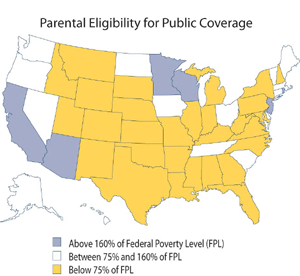|



The University of Michigan
555 South Forest Street
Third Floor
Ann Arbor, MI 48104-2531
T 734-936-9842
F 734-998-6341
/
|
 |
 |
Wisconsin's SCHIP Program Provides Lifeline for Mothers Leaving Welfare for Work THE PROBLEM
Federal welfare reform in 1996 broke the automatic link between cash assistance and Medicaid. Following this reform, there were decreases in public health insurance coverage in many states among both adults and children. Some states tried to offset these declines by increasing Medicaid eligibility levels for adults; a handful of states expanded eligibility under the State Children's Health Insurance Program (SCHIP) to include working adults.
New research funded by the Economic Research Initiative on the Uninsured (ERIU) at the University of Michigan shows that one state's SCHIP expansion, Wisconsin's BadgerCare, was successful in preserving health care coverage for a particularly vulnerable population of welfare leavers, single mothers. University of Wisconsin economist Barbara Wolfe and colleagues found that BadgerCare, one of the nation's few SCHIP programs covering adults, increased public coverage by up to 29 percentage points among one cohort of single mothers who left welfare for work.
BadgerCare was designed in part to complement Wisconsin 's welfare reform efforts, by providing health insurance to low-income families leaving welfare for often low-paying jobs without coverage. As of February 2004, low-income adults comprised two-thirds of BadgerCare's 114,000 participants.
The results show BadgerCare—a program that extends coverage to parents and children with incomes up to 200 percent of poverty—increased coverage levels substantially among welfare-leaving mothers. Overall, BadgerCare increased public coverage rates among the entire population of former cash assistance mothers by 17 percentage points.
|
|
Families leaving welfare for low-paying jobs face an increased risk of being uninsured, even though federal welfare reform law gave states new options to expand Medicaid for low-income parents. Many states are using Section 1931 authority to cover low income parents under Medicaid, but most states set the income threshold for parents well below the thresholds for children. States with available SCHIP funds can opt to cover parents and children at a higher income level under SCHIP, but they must first obtain a waiver from CMS. Wisconsin and several other states were able to take this approach. Federal matching payments under SCHIP are higher than under Medicaid, but, unlike the Medicaid entitlement, federal funds are limited by the state's SCHIP allotment. The approach taken in Wisconsin won't be feasible in every state, but it's a model for states with available SCHIP funds who want to increase support for low-income working families.
From Catherine McLaughlin,
Ph.D., Professor at the University of Michigan and Director of
ERIU |
THE FACTS
-
Low-income Americans account for 60 percent of the uninsured. In 2002, 39.4 percent of the uninsured in the U.S. were adults with incomes of less than 200 percent of the federal poverty level. Children in families with income under 200 percent of poverty accounted for an additional 21 percent of the uninsured.
-
BadgerCare increases public health coverage for low-income women. Prior to BadgerCare's expansion, children over age 5 and non-pregnant adults were eligible for public health coverage only if family income did not exceed 57 percent of poverty (roughly $7900 for a family of three in the year 2000). After the expansion, BadgerCare enrollees can have income up to 200 percent of poverty and remain eligible.
-
The jobs welfare leavers get tend not to include employment-based coverage. Adults leaving welfare often earn too much to qualify for Medicaid but are either in low-paying jobs that don't include health insurance coverage or earn too little to afford available private coverage. Research suggests that although welfare leavers who work tend to work full time, they earn between $7-8 per hour, experience more job turnover than average, and have family incomes that hover around the poverty line (Acs and Loprest 1999).

Q&A with Barbara Wolfe, Ph.D.
Barbara Wolfe, Professor in the departments of Population Health Sciences, Economics, and La Follette School of Public Affairs at the University of Wisconsin-Madison, examines vulnerable populations such as poor families. Also an affiliate and past director of the Institute for Research on Poverty, Wolfe recently co-authored the paper, "Extending Health Care Coverage to the Low-Income Population: The Influence of the Wisconsin BadgerCare Program on Insurance Coverage."
Q: What relevance do the lessons from BadgerCare have for health care policymakers?
A: Our research shows BadgerCare was successful in increasing coverage for this group of vulnerable women as they left cash assistance and moved into the labor force. The take-up rate has been surprisingly high relative to take-up of other programs, although there are still a lot of individuals eligible who aren't enrolled. The program has been successful in targeting this particular group and any state wanting to increase coverage in this group could do so by having a program similar to BadgerCare. Q: Why did Wisconsin expand SCHIP coverage to adults?
A: To complement welfare reform. The design of welfare reform in Wisconsin was to provide all the resources individuals would need to make the transition. The state provided a lot of assistance early on so these women could move into the workforce and be productive and self sufficient. Health care was an important component of this.
Q: What's BadgerCare's biggest success?
A: It serves as a bridge for those who've left welfare and who have gone to work. It has been particularly important as women's earnings have increased and they've lost eligibility for Medicaid. So it has increased the proportion of low-income women who are eligible for any sort of public coverage, and thereby has increased their coverage. They have been able to work without the insecurity of losing coverage.
Q: How successful was BadgerCare in preserving health care coverage for people who left welfare?
A: Our best estimate is that BadgerCare increased the public health coverage of all leavers by about 17 percentage points.
Q: How many welfare-leaving women remain uninsured?
A: We have substantial proportions that do remain uninsured. By the end of 2001, about 56 percent of the 1995 welfare leavers and 37 percent of the 1997 leavers did not have health insurance coverage.
Q: What's the take-away for health care policymakers in other states and at the federal level of Wisconsin's experience?
A: If you're goal is to decrease the proportion of low-income women who are uninsured, you can do so through a program such as BadgerCare. It gives you a tool to achieve a goal. But states have different goals.
Full
Q&A with Barbara Wolfe, Ph.D.
|
UPCOMING
|
This Research Highlight is the eighth in a series of research-based policy documents that address current questions and issues related to the health care coverage debate. The next Research Highlight will examine health insurance enrollment decisions. Research Highlights can be found on ERIU’s website at . |
Other ERIU Research Highlights
Summary of findings, data, and methods ERIU Working Paper #18 (Adobe PDF)

Back to top

Funded by The Robert Wood Johnson Foundation, ERIU is
a five-year program shedding new light on the causes and consequences
of lack of coverage, and the crucial role that health insurance plays
in
shaping the U.S. labor market. The Foundation does not endorse the findings
of this or other independent research projects.
|
